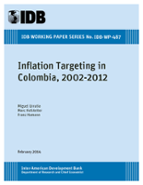Inflation Targeting in Colombia, 2002-2012
Date
Feb 2014
After decades using monetary aggregates as the main instrument of monetary policy and having different varieties of crawling peg exchange rate regimes, Colombia adopted a full-fledged inflation-targeting (IT) regime in 1999, with inflation as the nominal anchor, a floating exchange rate, and the short-term interest rate as the main instrument. This paper examines the experience of the Colombian Central Bank over the last decade, a period of consolidation and innovation of its IT strategy. The paper studies the increasing number of instruments used by the CB, including systematic foreign exchange interventions, announcements, and, sporadically, macro-prudential policies, capital controls, and changes in reserve requirements, among others. The study also examines some political economy dimensions that help explain the behavior of the CB during this period. To guide the discussion, a small-scale open-economy policy model is estimated.



